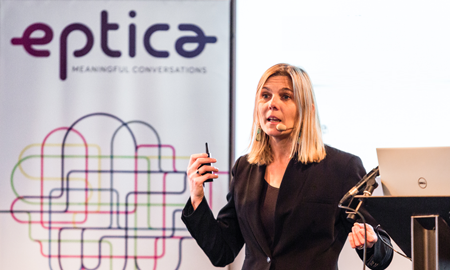Why technology needs to support the human element of CX

3 questions to Régine Vanheems, co-founder of the Observatoire du Cross-Canal et du Commerce Connected.
Régine, you gave a fascinating speech at the Eptica 2016 Customer Day, looking at how digital transformation is impacting consumer behavior and expectations. For the benefit of blog readers, can you give us some more detail on what you are seeing happening in the market?
Eptica: How do digital technologies change consumer behavior?
RV: Customer behavior has changed more in the last twenty years than in the previous twenty centuries! When the internet arrived, many thought that digitalization would remove the need for physical contact. However, in reality, this hasn’t been the case - consumers evolved, adopting technology to become autonomous, but didn’t abandon the real world. We now have a multi-device, multi-screen and multi-channel environment. Consumers move easily from the real to the virtual world and vice versa, as you can see from trends such as showrooming, researching online/buying offline and click and collect. This entanglement of the virtual and the real, this fragmentation of experience, can be difficult for brands to react to. Especially since consumers don’t behave the same in both worlds.
Eptica: In your opinion, how are brands coping with these developments?
RV: Multiplying the number of contact channels has generated freedom for consumers, but also four key issues:
1. Diluted responsibility
Customers detest being treated like a table tennis ball, passed between different points of contact. There is what I call a dilution of the responsibility of each touchpoint. Before, when there was only a single channel, the person that received the query was obliged to find a solution to the customer’s problem. Today, with multiple points of contact, none feels totally responsible for solving the consumer’s issue.
2. Brands not listening
A client who does not feel that a brand is listening to what they are saying has the right to get angry.
3. Not to be understood
Customers who change channel do so for good reasons, and their expectations and psychology will be different on each channel. They expect the brand to understand this.
4. A lack of help
Brands must make the customer journey as seamless as possible, understand their intentions and offer a simple, fluid experience. Many brands have embraced this – Darty's Connected Button is a good example. Building a winning strategy is not about just identifying and describing consumer behavior, but about understanding the client's psychology on each channel, the entire journey and how it links to the brand.
I am convinced that channels are not interchangeable from the customer point of view. Each way of making contact has a different role, so it is vital that brands understand what the customer expects on each. Whatever the channel, the consumer is looking for a seamless, personalized experience that understands the context around their relationship, and is above all authentic. This is reflected in particular by a return of the human to the customer experience.
Eptica: If customers are demanding a mix of humans and technology in their interactions, how do brands balance this?
RV: It is important to understand the logic behind customer journeys. There are two broad types of journeys: those that I’d describe as Liquid (based on a need for simplicity, ease and flexibility), which can be helped through self-service or even chatbots. At the other end of the spectrum there are Sublimated journeys, based on a need for emotion, pleasure, authenticity, advice and reassurance. Here the role of the human being is much more important. These Sublimated journeys create added value and clearly allow brands to differentiate themselves.
When looking at the mix of technology and the human, it isn’t an ‘either/or’ model - the two are complementary and you need both to succeed. The challenge is to integrate the human touch into a process that is currently focused more around technology. The golden triangle of an effective customer relationship rests on customer understanding, employee engagement and technology performance. Moving forward, it will be no longer a question of managing a relationship but of maintaining it constantly if you want to drive loyalty. Technology is key, but it must understand its place: to serve the human. So, brands should look at how technology can help them to serve customers better at their point of need, particularly by using natural language processing (NLP) capabilities to bring meaning and value to conversations.
In short, technology can help to support the relationship better by empowering employees so that they can add human value to the customer experience.







Comments